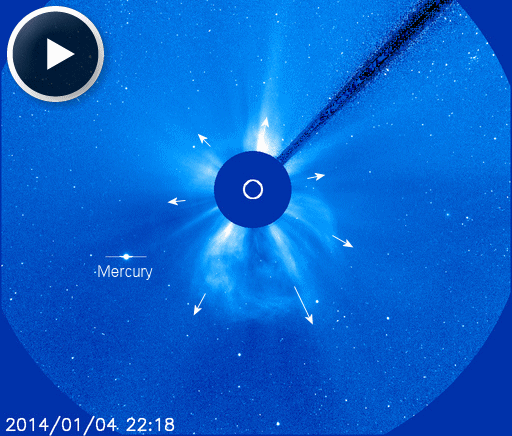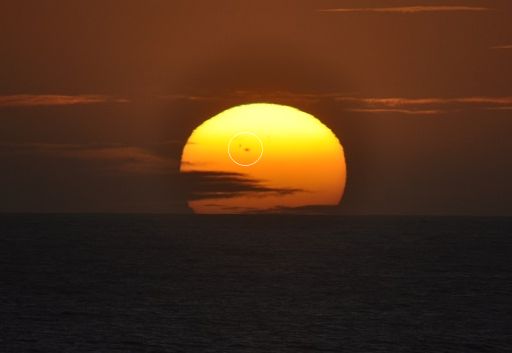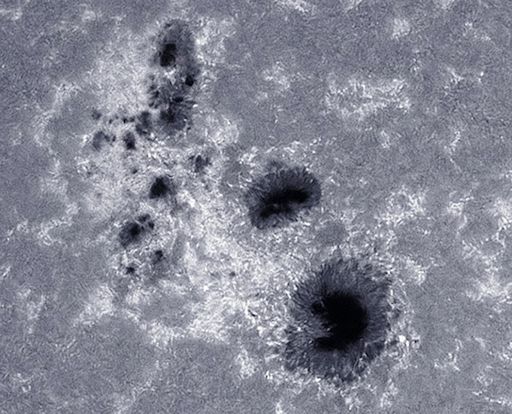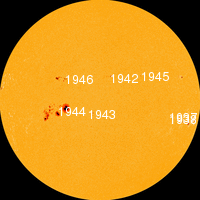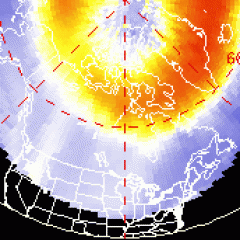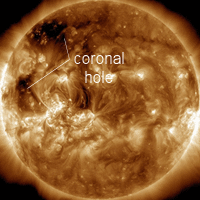~Space Weather Update~ INCOMING CME, UPDATED [1]
FLARES LIKELY TODAY: Giant sunspot AR1944 has a 'beta-gamma-delta' magnetic field that harbors energy for potent Earth-directed eruptions. NOAA forecasters estimate a 75% chance of M-class [2] flares and a 30% chance of X-flares [2] on Jan. 6th. Solar flare alerts: text [3], voice [4].
INCOMING CME, UPDATED: A coronal mass ejection (CME) is heading for Earth. The cloud raced away from the sun during the late hours of Jan 4th following a long-duration M4-class [2] solar flare from big sunspot AR1944. SOHO (the Solar and Heliospheric Observatory) recorded the explosion:
The assymetric CME is expected to deliver a glancing blow to Earth's magnetic field on Jan. 7th, possibly sparking G1-class [6] geomagnetic storms on Jan. 7th and 8th. High-latitude sky watchers should be alert for auroras. Geomagnetic storm alerts: text [3], voice [4].
Realtime Space Weather Photo Gallery [7]
GIANT SUNSPOT TURNS TOWARD EARTH: Watch this movie [8]. One of the largest sunspots in years, AR1944, is turning toward Earth. The active region contains dozens of dark cores, the largest of which is big enough to swallow three planet Earths. It's so big, sky watchers are noticing it as a blemish on the solar disk at sunset:
"Sunspot AR1944 was visible without using a solar telescope," reports Eddie Irizarry of Rincon, Puerto Rico, who took this picture at the end of the day on Jan. 5th. "Proper filters and extreme care should be taken when photographing the sun," he adds. "Unfiltered sunlight magnified by optics can cause serious eye damage."
Astronomers who have a safe solar telescope [10] are encouraged to take a closer look. "AR1944 has to be the most awesome sunspot ever," says Sergio Castillo of Inglewood, CA. "I cannot stop photographing it." Here is his latest image from Jan. 5th:
Castillo used a telescope capped with a "Calcium K" filter. Calcium K filters, which are sensitive to the blue glow of calcium ions in the sun's lower atmosphere, highlight the bright magnetic froth that often forms around a sunspot's dark cores. AR1944 is very frothy indeed.
Magnetic froth does not necessarily herald an explosion, but it does guarantee a photogenic sunspot. Scan the gallery for more images:

Solar wind
speed: 358.2 km/sec
density: 2.1 protons/cm3
explanation [12] | more data [13]
Updated: Today at 1617 UT
X-ray Solar Flares
6-hr max: C3 1001 UT Jan06
24-hr: C7 0019 UT Jan06
explanation [14] | more data [15]
Updated: Today at: 1600 UT
![]()
Daily Sun: 06 Jan 14
Growing sunspot AR1944 has a 'beta-gamma-delta' magnetic field that harbors energy for X-class [2] solar flares. Credit: SDO/HMI
![]()
Sunspot number: 225
What is the sunspot number? [17]
Updated 06 Jan 2014
Spotless Days
Current Stretch: 0 days
2013 total: 0 days (0%)
2012 total: 0 days (0%)
2011 total: 2 days (<1%)
2010 total: 51 days (14%)
2009 total: 260 days (71%)
Since 2004: 821 days
Typical Solar Min: 486 days
Update 06 Jan 2014
The Radio Sun
10.7 cm flux: 215 sfu
explanation [18] | more data [19]
Updated 06 Jan 2014
![]()
Current Auroral Oval:
Switch to: Europe, USA, New Zealand, Antarctica
Credit: NOAA/POES
![]()
Planetary K-index
Now: Kp= 1 quiet
24-hr max: Kp= 1 quiet
explanation [21] | more data [22]
Interplanetary Mag. Field
Btotal: 2.4 nT
Bz: 1.8 nT south
explanation [23] | more data [24]
Updated: Today at 1616 UT
![]()
Coronal Holes: 06 Jan 14
There are no large coronal holes on the Earthside of the sun. Credit: SDO/AIA. ![]()
